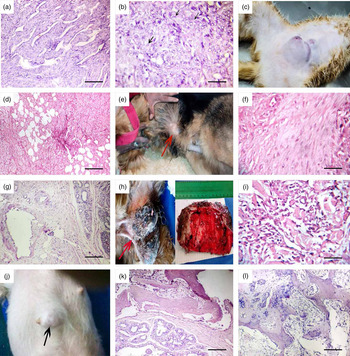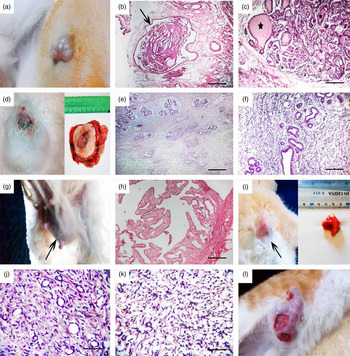mammary tumors in cats merck
It is a common finding in older female dogs and cats that are not spayed but they are found in other animals as well. Approximately 45 of canine mammary tumors are malignant cancerous.

Download Pdf The Merck Veterinary Manual Free Epub Mobi Ebooks Veterinary Merck Hardcover Book
Approximately 50 of them are malignant.

. Mammary neoplasms are uncommon in male dogs accounting for less than 1 percent of these types of tumors. Other forms of breast and mammary cancer in a cat include adenomas duct papillomas and sarcomas. Invasion ulceration lymphatic invasion and lymph node metastasis is common.
Almost all 99 of feline MGT occur in intact females Lana et al 2007. Approximately 90 of mammary tumors in cats are malignant cancerous. Mammary cancer is usually a malignant adenocarcinoma that appears in one or more of a cats breasts.
They are prone to spread metastasize to the lungs and lymph nodes. Only 15 are benign. When it appears in cats it can be fatal even if treated with surgery radiation and chemotherapy.
Hyperplasia occurs within 12 wk after estrus or 26 wk after progestin treatment. Female cats generally develop mammary cancermalignant adenocarcinomaswhen they are about 10 to 14-years-old. Most tumors occur in the 2 sets of glands closest to the hind legs.
The mammary glands in dogs and cats are associated with their nipples and extend from the underside of the chest to t. This type of cancer is very aggressive and hard to treat as it spreads quickly. Mammary tumors are the most common neoplasm in intact female dogs and account for approximately half of all neoplasms in them.
The incidence of mammary tumors is higher in dogs than in any other domesticated animal and is three times. Mammary tumors in cats are most often seen in older average age 11 years nonspayed females. AJ Debiasse a technician in Stroudsburg PA contributed to this article.
Tumors originating in these glands account for the third most common type of feline cancer after lymphoma and skin cancer. Sarcoma SCC and mucinous carcinoma subtypes are less common. Mammary tumors in cats are most common in older average 11 years intact females.
Approximately 90 of mammary tumors are malignant in cats and cats have fewer complex and mixed tumors than dogs. Cats spayed before 6 months or 12 months of age have a 91 or an 86 reduction respectively in the risk of mammary carcinoma development compared to intact cats. The cause of mammary tumors is unknown but hormones play an important role in their development.
Mammary cancer in cats is the third most common type cancer seen in this species. A mammary tumor develops as a result of abnormal replication of the cells that make up the breast tissue. Hayes and Mooney 1985.
Mixed mammary tumors and sarcomas are less commonly diagnosed than carcinomas. The risk is much lower for spayed female dogs male dogs and cats of either gender. A mammary tumor is a neoplasm originating in the mammary gland.
Females as well as males can develop this form of cancer. Benign tumors of the feline mammary gland. More than one tumor may be.
Median age on presentation is 10 to 11 years. Occurring more than 95 percent of the time in females it is the most frequently diagnosed type of feline cancer. Parity does not affect feline mammary carcinoma development.
There are several different types of. A mammary fibroadenoma is a benign mammary gland tumor. Several reports have documented a strong association between the use of contraceptives and the development of benign or malignant mammary masses in cats.
The cause of mammary tumors is unknown however hormones play an important role in their development. This incidence is huge yet awareness among owners of female dogs is lacking. One of the reasons veterinarians recommend spaying cats is that it is an easy affordable and efficient way to prevent mammary or breast tumorsThese tumors are a huge problem for cats.
What many pet owners dont know is that the incidence of mammary tumor development in dogs is higher than in women as one in four unspayed female dogs are affected. According to the American College of Veterinary Surgeons 85 of them are cancerous ie. There are 10 mammary glands in dogs any of which may be the site of a tumor.
Feline mammary carcinoma is highly malignant and generally associated with a poor prognosis although studies suggest the range of survival times in affected cats is broad. There are also generalized blood cell splenic and digestive tract forms of mast cell sarcoma. The median age for MGT development in the cat is 10 years of age or older.
Feline Mammary Gland Tumors. Also see professional content regarding mammary tumors Mammary Tumors in Dogs and Cats Tumors arising from mammary tissue are commonly observed in older intact female dogs and cats. Mammary tumors are extremely common in dogs.
Sarcomas mucinous carcinomas duct papillomas adenosquamous carcinomas and. Mast cell tumors are a kind of tumor named for the type of skin cell from which they grow. Benign mammary tumors can become detrimental to the rats health only if they are.
In cats the vast majority of mammary tumors are malignant. Feline mammary hypertrophy is considered to be a hormone-dependent dysplastic change in the mammary gland. Mammary tumors can be benign non-cancerous or malignant cancerous.
In fact spaying before the first or second heat cycle significantly reduces the risk of developing mammary tumors. Mammary tumors in cats are usually malignant 85-93 80 of feline mammary tumors are ADC with tubular papillary solid and cribriform subtypes most common. Benign mammary tumors are fibrous noninvasive and movable when palpated.
Most feline mammary tumors are adenocarcinomas with tubular or papillary types more common than solid or mucoid types. Mast cell tumors are the second most common skin tumor in cats. The risk of this disease can be greatly reduced by spaying the dog before it first comes into heat.
These two forms of the disease have different diagnostics treatments management and prognosis. Approximately 85 of feline mammary tumors are malignant and are histologically classified as adenocarcinomas. Feline mammary hypertrophy is considered to be a hormone-dependent dysplastic change in the mammary gland.
The tremendously enlarged glands may appear erythematous and some of the skin may be. The risk of developing this cancer is twice as high in cats. Women get breast cancer female dogs get mammary cancer.
Mammary tumors are more common in intact than in spayed females. Cats spayed before 6 months of age have a 7-times reduced risk of developing mammary cancer and spaying at any age reduces the risk of mammary tumors by 40 to 60 in cats. Most canine mammary tumors that are going to cause death do so within 1 year.
Mammary Cancer in Cats Explained. Cancer in general afflicts an estimated 30 percent to 40 percent of all cats and one-third or so of these malignancies involve the mammary glands. Fortunately mammary fibroadenomas are more common than their malignant counterparts mammary adenocarcinomas.
More than a quarter of unspayed female dogs will develop a mammary tumor during their lifetime. Histologic grading of these tumors is achieved using the Elston and Ellis. Hyperplasia occurs within 12 wk after estrus or 26 wk after progestin treatment.
The tremendously enlarged glands may appear erythematous and some of the skin may be. Mammary tumors are the third most common tumor in the cat after hematopoietic neoplasms and skin tumors Misdorp 2002.

Mammary Tumors In Dogs And Cats Reproductive System Msd Veterinary Manual

Pathological And Immunohistochemical Microscopy Of Natural Cases Of Canine And Feline Neoplastic Mammary Lesions Microscopy And Microanalysis Cambridge Core

Related Diseases Merck Animal Health Usa

Pathological And Immunohistochemical Microscopy Of Natural Cases Of Canine And Feline Neoplastic Mammary Lesions Microscopy And Microanalysis Cambridge Core

Metastatic Tumors In Animals Integumentary System Msd Veterinary Manual

Mammary Tumors Vis Medicatrix Naturae Veterinary Clinic Facebook

Mammary Hypertrophy In Cats Reproductive System Merck Veterinary Manual

Ovariohysterectomy Dog Veterinary Medicine Animal Hospital Vet Med
